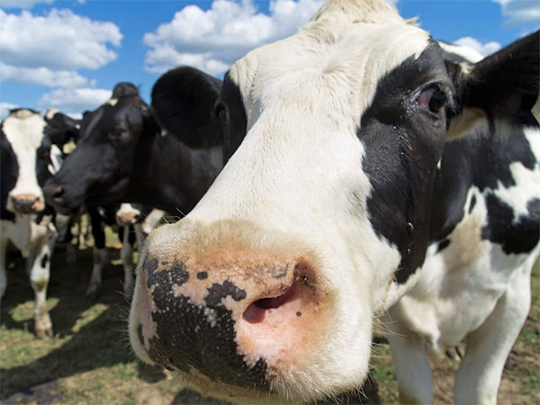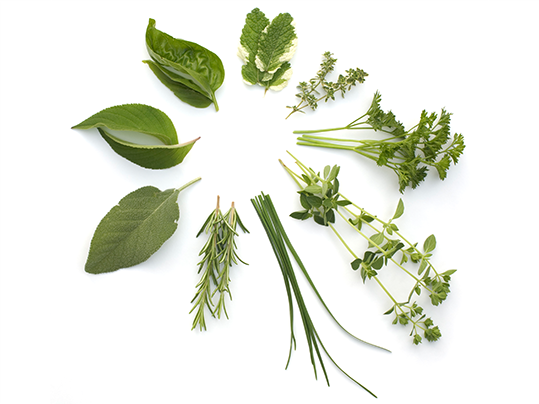Phytogenic support for protein efficiency in dairy cows
Everyone is talking about protein efficiency in dairy cows. Did you know that optimizing rations with phytogenics represents a cost-effective way to ensure efficiency in livestock?
So true. Phytogenic feed additives (PFAs) have been able to substantially up-value ruminant rations for years – and their future is promising.
But why do natural substances like e.g. essential oils, saponins, spices and condensed tannins have aroused the interest of science and found their way into animal nutrition, especially in recent decades?
And in which way are PFAs able to support the protein efficiency in dairy cows?
After reading this article you will know about...
… the protein supply in ruminants
… the importance of a balanced Nitrogen (N) supply
… how phytogenics are able to improve potein and feed efficiency
What about the protein supply in ruminants?

The protein supply in dairy cows is ensured by a sufficient content of crude protein in the ration and the amount of available protein in the small intestine.
Crude protein is broken down to ammonia in the rumen with the help of microbes, which then convert the ammonia into precious microbial protein, given that the microbes are provided with energy from fermentable carbohydrates.
If there is a crude protein surplus and/or energy deficiency, an ammonia surplus is produced which must be detoxified via the liver in the form of urea, being measurable in the blood, urine and milk.
The decisive factor is the amount of protein that reaches the small intestine, where it is available to the animal. This amount mainly consists of microbial protein (50-75%) and to a lesser extent of undegradable protein, which passes the rumen and reaches the small intestine directly.
P – the protein issue
As an adequate supply of amino acids is crucial for high milk and milk protein production, dairy cows are often fed rations containing high concentrations of crude protein.
Though only a part of the protein inputs from the feed are effectively converted to animal product. In dairy, the protein efficiency (defined as the ability of a dairy cow to effectively metabolize protein and non-protein N ingested into milk protein, expressed as percentage) is 25%.
This means, that under typical feeding conditions, the cows are able to convert about 25% of the total protein consumed, to milk, implying that from the remaining 75%, part is used for maintenance (25-45%) and the rest finally ends up as waste products and is excreted.
Did you know?
To produce one kg of milk, about 500 liters of blood flow through the udder, which means that for today’s high-performance cows about 20,000 liters of blood are required. True top athletes, our dairy cows, aren´t they?
N like nitrogen
Next to adequate crude fiber and feed structure supply, energy and further nutrients in rations, sufficient nitrogen is the most important prerequisite for a high protein synthesis in ruminants. A balanced N supply reduces the risk of energy shortfalls and positively affects the cow’s fertility, whereas an oversupply of N burdens the liver as the main metabolic organ and should therefore, be avoided best possible.
Nitrogen (N) excretion in manure is a consistent challenge facing agriculture as it seriously burdens the environment as nitrous oxide (N2O), ammonia (NH3) and nitrate (NO3) and is highly correlated with the dietary N intake. So, it seems obvious to simply feed less protein hence reducing N excretion. However, this strategy can only be implemented in practice, if neither milk production performance, nor animal health or fertility are affected thereby.
The good news:
It is possible to upgrade protein efficiency in dairy cows with the help of today’s plant-based nutrition tools available and without facing performance losses or the like. From an environmental and economical view, this should be a desirable way to go.

How can precious bioactive substances, as they are found in PFAs, improve protein efficiency in dairy cows?
Phytogenic feed additives have been able to substantially up-value ruminant rations for years. Well-formulated formulations, aligned to the animal’s needs, are able to support protein efficiency hence helping to keep protein losses low. There is evidence that these natural, holistic solutions unfold their impact on three levels and in various sections of the digestive tract:

In the rumen
An improved rumen function leads to improved energy and protein efficiency ratio, increasing the proportion of metabolizable bypass protein and microbial protein (the latter shows a very good amino acid balancing to build up milk casein). Consequently, this will lead to lower ammonia losses from the rumen, via the liver (where it is transformed to urea) into the urine.
A reduction of protein degradation
A reduction of the protein degradation in the rumen will increase the level of bypass protein, and thus, lowering protein losses.
Selected phytogenics
The natural ingredients of selected PFAs positively influence the protein digestibility and absorption in the small intestine. By increasing the proportion of metabolizable bypass protein and microbial protein, the share of indigestible protein is minimized. This will reduce protein in feces and lower ammonia concentrations.
The positive performance effects of a well-formulated phytogenic feed additive (Actifor® Pro) are illustrated in figure 3. Phytogenic substances have shown to reduce both protein losses in urine and feces. This means that the intestinal digestibility could be improved, and less ammonia was transformed into urea. The more efficient use of N for milk production, maintenance and growing led to an improved protein efficiency by 2.7%. Optimizing protein and feed efficiency in ruminants improves the milk quality by raising its protein content whilst simultaneously decreasing urea concentration.
Another study using Actifor® Pro was undertaken, to look at the potential to improve performance in dairy cows over a period of 12 weeks (see table 1 and figure 4). The inclusion of the phytogenic feed additive mainly increased milk production (+ 1.6kg/cow/day) and the energy corrected milk production (+ 2.5kg/cow/day). At the same time, body condition score was increased by 0.15 (table 1).
| Control group | Actifor® group | Actifor® Pro Effect | p-value | |
|---|---|---|---|---|
| DIM at beginning (days) | 84.9 | 87.6 | NS | |
| Milk yield (kg/cow/day) | 27.9 | 29.5 | +1.6 | 0.04 |
| Energy Corrected Milk (kg/cow/day) | 30.5 | 33.0 | +2.5 | 0.01 |
| Fat corrected milk (kg/cow/day) | 30.0 | 32.6 | +2.6 | 0.02 |
| BCS change | +0.07 | +0.22 | +0.15 | 0.05 |
| Energy output (Mcal/day) | 20.5 | 22.3 | +1.8 | 0.02 |
Supplementing lactating dairy cows with well selected phytogenic feed additives appears to be a promising strategy to improve milk performance, whilst at the same time reduce protein losses in dairy production systems. There is evidence that optimizing rations with certain plant-based feed additives represents reliable, cost effective ways, ensuring feed efficiency respectively protein efficiency.
A target, dairy farmers are always focusing on, aren´t they?

Elisabeth Rohrer
After her study in agriculture sciences at the university of natural resources and life sciences in Vienna, Elisabeth joined the Delacon team in December 2013 as Technical Communications Manager - a position, she always exerted with pleasure. Since 2021, her task areas have been extended and thus, she is also supporting colleagues in writing offside the technical focus as Content Manager. Elisabeth describes herself as a great animal and nature lover and prefers to spend her free time high up in the mountains with her little family, away from the hustle and bustle.

Thierry Aubert
Thierry Aubert can look back on 15 years of experience in the premix, feed and meat industry. Since the beginning of his career, Thierry is in regular exchange with the farmers to understand their challenges and needs. In 2013 he joined Delacon as Species Leader Ruminants. With his team, he is in charge of the global product development for the ruminant species and customer technical support. Since spring 2018, his task areas have been extended: At the moment, he is also responsible for the coordination of the Reginal Technical Managers worldwide. In his leisure time, he likes to go running and already participated in several marathons.











Considering rising concerne of dairy farmers for improving productivity of their animals at reduced production cost and increased awareness of dairy food consumers globally for antibiotic residue free wholesome food for healthy living , there appears great scope for expanded use of phytogenic feed additives in animal production systems in coming future.